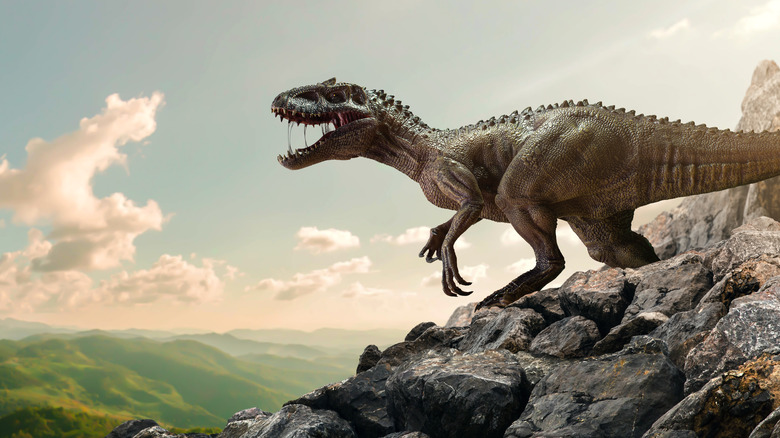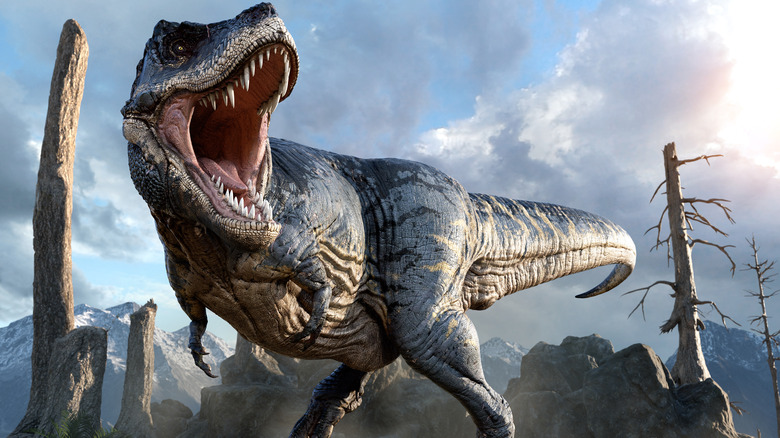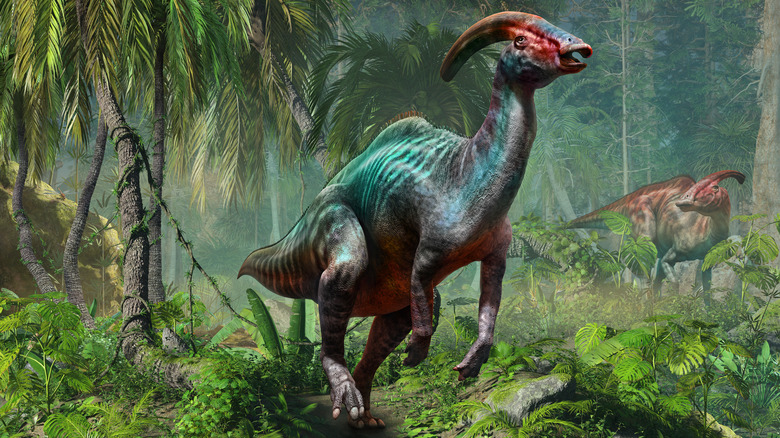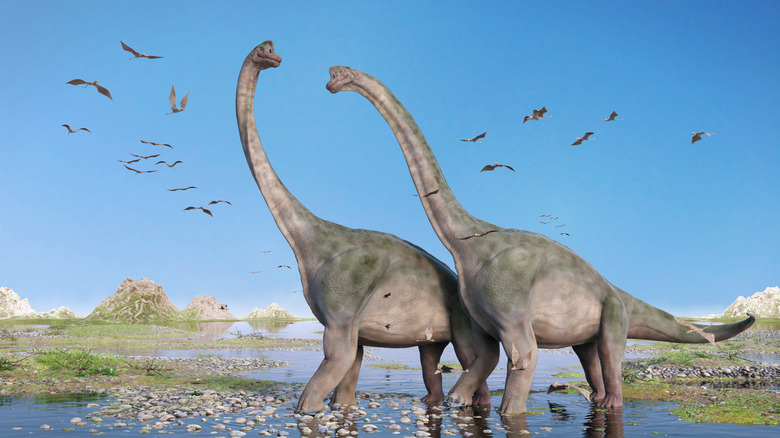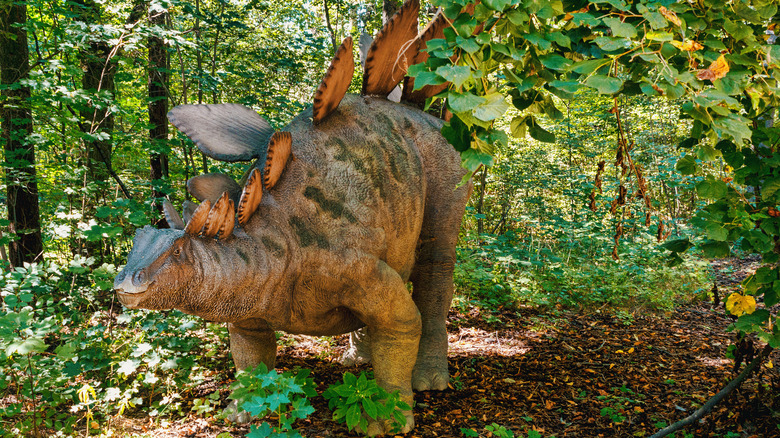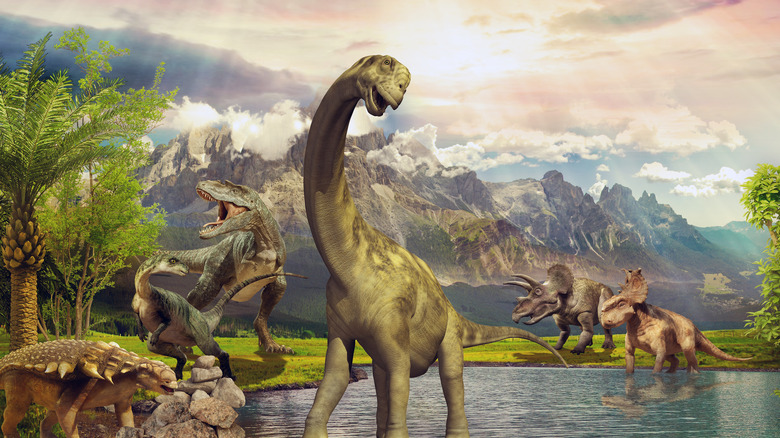The Sounds Dinosaurs Made Are Probably Not What You Envisioned
"A ROAR rises up from the jungle, deafening. The trees shake as something very, very large plows ahead ..."
That was the opening text of the classic "Jurassic Park" screenplay. While that initial roar turns out to be a bulldozer, it also serves to foreshadow coming events. Throughout the blockbuster film, terrifying dinosaurs filled the Jurassic-inspired forest with resounding sounds of doom. The Tyrannosaurus rex roared more than 20 times, establishing itself as the dominant predator. Velociraptors growled over an ominous soundtrack, making an otherwise mundane restaurant kitchen a petrifying backdrop. Even the venom-spewing dilophosaurus let out a chilling-inducing squawk to create what Screen Rant reported was "one of the most horrifying sequences in the entire film."
These cinematic soundtracks painted an excellent picture in movie-goers' heads of life at a time when dinosaurs ruled the earth. However, according to BBC Future, real-life dinosaurs sounded nothing like this at all. New research making use of the most up-to-date technology reveals that dinosaurs probably didn't sound how you'd expect. From baby-like coos to orchestral-esque vocal performances to utter silence, let's dive into the sounds of these Cretaceous creatures.
T. rex cooed like a baby
Forget everything you heard about T. rex. CBC Radio reports that despite popular opinion, the 15,432-pound theropod was not exactly storming through the trees, roaring like a modern-day lion. Incidentally, the dinosaur didn't bite like a lion either (via National History Museum). Sure, T. rex packed triple the bite power of a lion, but you'd never know this if you listened to the sound it made.
Based on the dino's unique anatomy, it is more likely that the creature cooed like a baby while stalking the landscape. This fact stands in stark contrast to practically every picture drafted in the dinosaur's likeness, including the one above, which features T. rex with an unhinged mouth so wide you can practically hear the roaring through the screen. Therapods are believed to have been the predecessors to birds (via the National History Museum). Therefore, researchers like Chad Eliason of the University of Texas say the sounds T. rex's made would have been more similar to doves than lions. Vocal inflections might have included soft cooing, gentle hooting, and a booming sound so low it was more easily felt than heard.
Herbivorous hadrosaur sounded like a symphony
BBC Future reports that there were some dinosaurs that produced voluminous, thundering sounds that might have been enough to shake the forest, "Jurassic Park" style. However, those sounds were a far cry from anything you might describe as a roar. Instead, these creatures sounded more like wind instruments being blown into and broadcast over a booming set of speakers.
Notedly, one such dinosaur believed to make this type of sound was the duck-billed hadrosaur, a clumsy-looking herbivore whose name loosely translates to "bulky lizard" (via ThoughtCo.). While this dino's diet was far from imposing, it could grow to be 10 times the size of a modern elephant. And its 20-ton body would have included a "bizarre skull structure" consisting of a vast hollow crest (per BBC Future).
According to Berkley researchers, the hadrosaur's crest contained elongated, looped nasal passages so big that some would have been capable of breathing fire through their noses (although there is no evidence they did so). Scientists now suspect those lengthy nostrils enabled the hadrosaur to change tone and increase the volume of its cacophonous, wild cry. Curator of paleontology Tom Williamson tried to envision the hadrosaur's earth-shaking, vibrating bellow and drew the following conclusion (via BBC Future): "I would describe the sound as otherworldly."
Today, the animal's fossils, featuring the captivating musical crest at the top of its head, inspired an Arizona State University student named Courtney Brown to create an instrument you can blow into that looks and sounds just like the hadrosaur (via KJZZ).
Sauropods were basically walking trombones
As it turns out, the hadrosaur wasn't the only dinosaur capable of piping out loud vocals that mimicked a wind instrument. Sauropods, like the brachiosaurus and diplodocus, sported enormously long necks that could reach lengths of about 50 feet, according to PeerJ researchers from the Department of Earth Sciences and the University of Bristol. The scientific community largely associates these massively long necks with reaching, grazing, and in some cases, mating — or enhancing attractiveness (via Live Science).
Now, they suggest these necks allowed sauropods to trample the forest while making sounds similar to trombones (per BBC Future). Think of it this way: The pitch and tone a trombone produces are based on the length of its extension, according to Yamaha. As sound travels through the lengthy tubing, the notes ascend or descend depending on the slide position. In a similar vein, sauropods appeared to have comparable vocal capabilities — they could change the pitch and tone of their voice as air traveled through their tubular necks.
Could this explain their cartoonish flip-top heads being comprised of mostly mouths and air? Nobody can say for sure.
Complete and utter silence meant impending danger
If you're starting to think the entire Cretaceous landscape was rocking out like a high school marching band in the stands at a football game, think again. According to CNN, at least one dinosaur was rendered almost completely mute, producing about as much sound as a turtle. This Cretaceous creature was the Struthiosaurus austriacus (via ScienceAlert). Like the present-day turtle, this dinosaur sported a rough exterior complete with a hard shell and formidable spikes, earning it the nickname "living fortress."
We can learn a lot about the importance of sound and communication from the S. austriacus, which reportedly sported the shortest cochlea of any dinosaur known to humankind. The cochlea, found in the inner ear, plays a huge role in hearing capabilities. The smaller it is, the less sound an animal can hear. Sporting the shortest cochlea made hearing and vocalizing minimal for this dinosaur, and because of this, it was forced into a life of solitude.
This life of loneliness also supports the theory that vocalization for dinosaurs was related more to social activities like mating and communicating than it was to hunting (via BBC Future). In the words of paleontologist Marco Schade (per CNN), "Carnivorous dinosaurs very likely tended to hunt silently, which is the opposite from their depiction as theme park monsters in 'Jurassic Park."
From this perspective, it's clear that a silent forest was the truly terrifying sound. The hush signified carnivorous dinosaurs on the prowl.
Harmonious chirps pierced through the trees
According to BBC Future, another unlikely sound piercing through the trees back when dinosaurs ruled the earth was chirping, the kind we now associate with birds and crocodiles. Based again on the length of the cochlea, it appears dinosaur parents were sensitive to high-pitched sounds, which they likely used to locate their babies. "Given that baby birds and baby crocodiles chirp, it's reasonable to infer that baby non-bird dinosaurs did as well, and that their parents listened to them and cared for them just as crocodile and bird parents do," explained Bhart-Anjan Bhullar of the Peabody Museum of Natural History.
As these sounds of Jurassic forests come to life, they paint a seemingly more accurate picture, but it's still not entirely reliable. For all the fossils we have found, one essential key to dinosaur sounds is missing — a syrinx. It is the voice box of modern-day songbirds, and unlike the larynx, which is located in the windpipe, the syrinx sits right next to the heart to produce the unmistakable chirps and whistles we hear from birds (via the University of Texas at Austin).
No syrinx has ever been found in a dinosaur fossil, and many scientists believe that it didn't exist (per the University of Texas at Austin).
